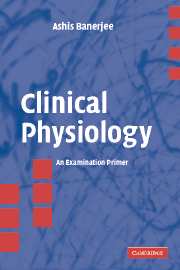7 - Respiratory System
Published online by Cambridge University Press: 05 June 2016
Summary
Introduction
The respiratory system allows oxygen delivery to, and carbon dioxide removal from, the bloodstream, which are mediated via the conducting airways and a gas-exchange region. The exchange of gases is termed respiration.
Functional components of the respiratory system
• The pump that drives ventilation: chest wall and pleura; respiratory muscles (intercostals and diaphragm). These can be supplemented by the accessory muscles of respiration (sternomastoids, scaleni, pectorals, latissimus dorsi) in situations where the work of breathing is increased. Inspiration is an active process, being brought about by negative intra-pleural pressure generated by contraction and descent of the diaphragm and rib cage elevation by the intercostal muscles. The contraction of the diaphragm expands the chest wall laterally (bucket handle effect) and antero-posteriorly (pump handle effect). The phasic action of the intercostal muscles helps in stabilisation of the chest wall. Expiration is mainly passive and dependent on the elastic recoil of the lungs and chest wall. Active expiration occurs during exercise and in hyperventilation states and primarily involves the anterior abdominal wall musculature, assisted by the internal intercostal muscles.
• The distribution of ventilation: upper respiratory tract, conducting airways, respiratory bronchioles. Apart from air conduction, these air passages are involved in the humidification and warming of inspired air.
• Perfusion: pulmonary arteries and veins, capillaries.
• Bronchial clearance: muco-ciliary escalator; macrophages.
• Alveolar clearance and defence: alveolar macrophages; pulmonary lymphatics; humoral mediators.
The process of gas exchange itself involves:
Ventilation of the lungs;
Capillary perfusion of ventilated alveoli;
Diffusion across the alveolar-capillary membrane.
The upper respiratory tract
This comprises:
• The nose, which serves the following functions:
Air conduction.
Particle and micro-organism clearance by the muco-ciliary mechanism, which comprises the pseudostratified ciliated epithelium, mucous blanket and the mucus-producing glands. The inspired air is thereby cleaned and filtered. In general, particle diameter requires to be greater than 10 mm to allow nasal filtration.
Humidification and warming of inspired air by a counter-current heat and fluid exchange mechanism.
Perception of smell, via the olfactory neuroepithelial receptors.
Contributes to more than 50% of total airway resistance normally.
• The pharynx, which is involved in swallowing, while simultaneously preventing aspiration of food into the lungs.
• The larynx, which is involved with:
The production of speech, which comprises the three components of phonation, resonance and articulation.
- Type
- Chapter
- Information
- Clinical PhysiologyAn Examination Primer, pp. 115 - 139Publisher: Cambridge University PressPrint publication year: 2005



